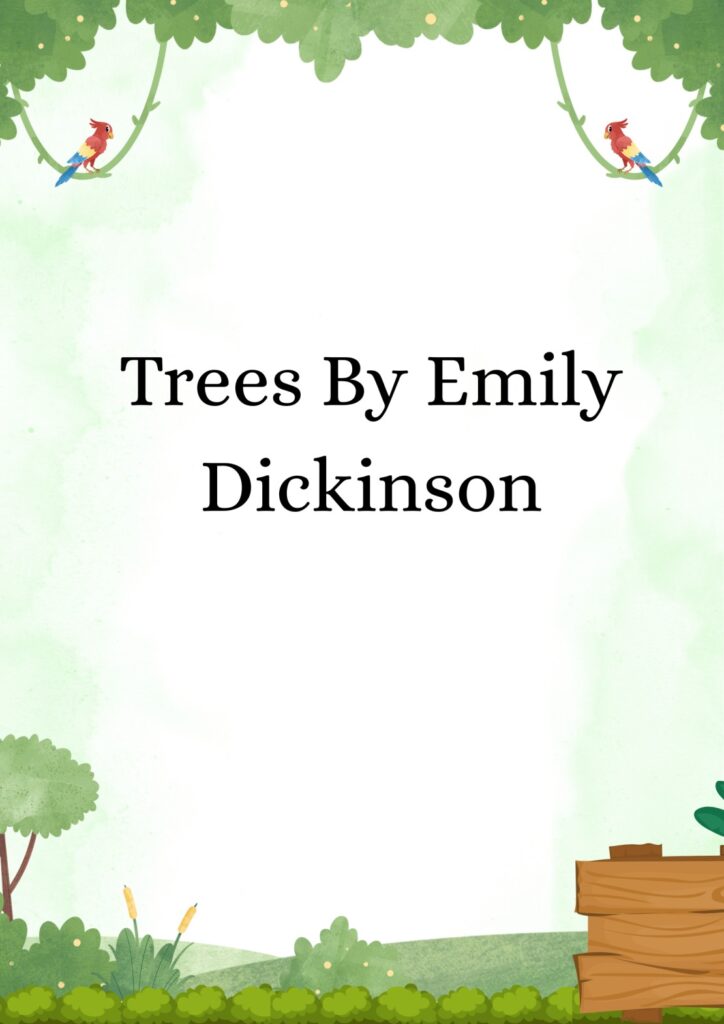Explore the summary of Trees by Emily Dickinson, a profound poem reflecting nature’s silent strength and spiritual beauty. Understand its themes, meaning, and poetic style in simple language.
Trees Poem Analysis By Emily Dickinson

BUY EMILY DICKINSON POEMS BOOK ON AMAZON
Summary of Trees Poem By Emily Dickinson
Introduction
Emily Dickinson’s poem “Trees” is a creation in which the tree is presented as a living, soulful and philosophical entity, not just a natural structure. For Dickinson, trees are not just green pillars standing in forests or gardens – they are symbols of life, patience, silent power, spirituality and stability of the soul.
In the poem, the poet sees the lifestyle of trees in human form – they teach us how to live in silence, how to bend but not break, how to give without complaint. Trees are divine truths found through nature for Dickinson.
1. Trees – The Quiet Souls of Nature
Emily Dickinson sees trees as saints of the earth. They just stand silently, without speaking, without moving, but their very existence says a lot.
Trees:
Bear the sun
Face the rain
Bend in the storm
But remain connected to the roots
The poetess wants to show that a tree never complains, never expects, but still it gives to everyone – shade, fruits, flowers, air, wood.
So for Dickinson, trees are such ideal creatures, which need no show-off, no reward.
2. Trees and Life – Lesson of Patience
Dickinson says that humans are always running – towards fame, wealth, relationships, and ambition. But trees are stable – they grow with time while staying in the same place.
They teach us to:
Be patient
Embrace every season
Build strength and stability within ourselves
Just like an ascetic sitting in yoga — trees practice silent meditation. Dickinson suggests that there is no greater teacher than trees.
3. Seasons and Trees – The Art of Embracing Change
Emily Dickinson beautifully shows that trees welcome every season — be it the greenery of spring, the warmth of summer, the drenching rain, or the falling leaves of autumn.
She says that just as a tree sheds its leaves and still remains calm, we must learn to shed our sorrows, attachments, and desires in life.
Trees teach that:
Fall is not the end
After autumn comes spring
New life is always born
This is the law of nature, and trees are a living example of it.
4. Trees – Creatures that speak in silence
Dickinson says that trees never say anything, but their silence is their communication.
When the leaves rustle, they talk to nature
When the flowers bloom, they express gratitude
When the branches bend, they show humility
The poetess tells that humans should give more importance to emotions than words, and they can learn that emotion from trees.
5. Soul and trees – Depth of spirituality
Emily Dickinson’s poems always have a spiritual perspective hidden in them.
She sees trees not just as a part of nature, but as an extension of the soul.
Trees grow towards the sky – as the soul grows towards God
Their roots are deep in the earth – as the soul is connected to truth
They bear fruit, provide shade – as the soul gives love and service
Dickinson indicates that the true expression of the soul can be seen in the form of a tree.
6. Trees and womanhood in Dickinson’s view
Emily Dickinson herself was a gentle but firm woman, and she sees a womanly restraint, strength and tolerance in trees.
Trees are full of inner strength, but appear gentle from outside
They do not eat their fruits themselves, but give them to others
They save, nurture, but without any expectations
It also becomes a symbol of women empowerment and sacrifice.
7. Language and style of the poem – Dickinson’s unique poetic vision
This poem of Emily Dickinson is written in very simple words, but has deep philosophical layers hidden in it.
Her lines are short, but they have depth of symbols and expressions
She gives personality to trees, makes them living characters
Her poetry gives us the vision to see the soul within nature
Trees Poem Themes : –
Relation between nature and soul : Trees are seen as the expression of the soul.
Importance of patience and peace : The stability of the tree teaches us the lesson of inner peace
Unity of man and nature Man is not separate from nature, he is a part of it
The power of silence and humility A lot can be said even by being silent
Accepting change Changes are necessary and beautiful like the weather
Lessons We Learn)
Be patient and stable in life like trees.
True happiness lies in giving without any expectations.
Learn to accept change in life.
Keep your soul deep like roots.
Every human being should understand his existence by connecting with nature
Conclusion
Emily Dickinson’s poem “Trees” is a wonderful example of how ordinary things have extraordinary meanings. Trees, which we see every day, are spiritual teachers, silent hermits, and guardians of the soul for Dickinson.
This poem doesn’t just show us trees — it introduces us to our own roots.
“To stand like a tree
To bend in the storm, but not to fall
To give, give, and give —
But to say nothing
This is the true practice of life.”
Recommended Reading
I’m Wife – I’ve Finished That By Emily Dickinson
Success is Counted Sweetest By Emily Dickinson
Hope is the Thing with Feathers By Emily Dickinson
Because I Could Not Stop For Death By Emily Dickinson
The Soul Selects Her Own Society By Emily Dickinson